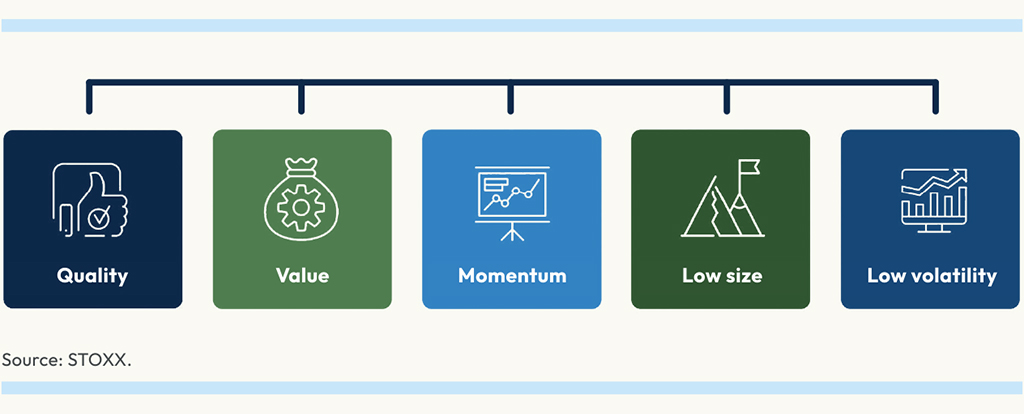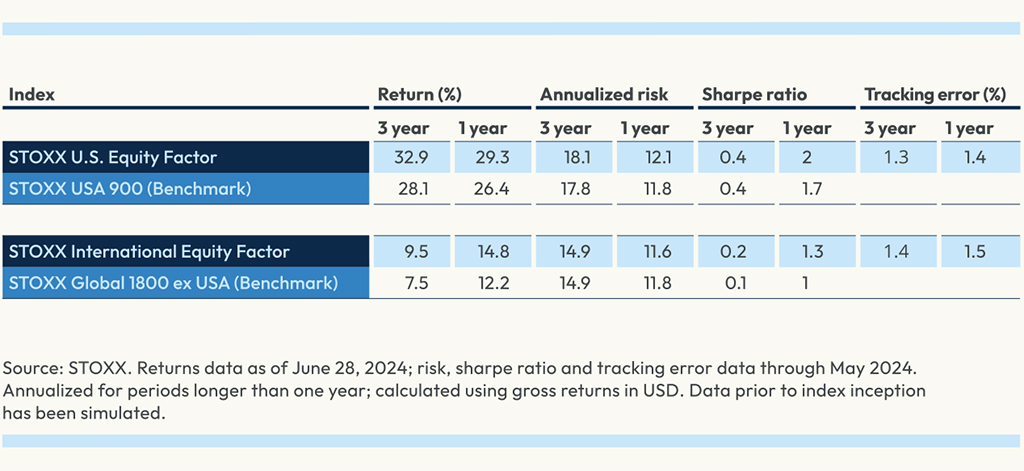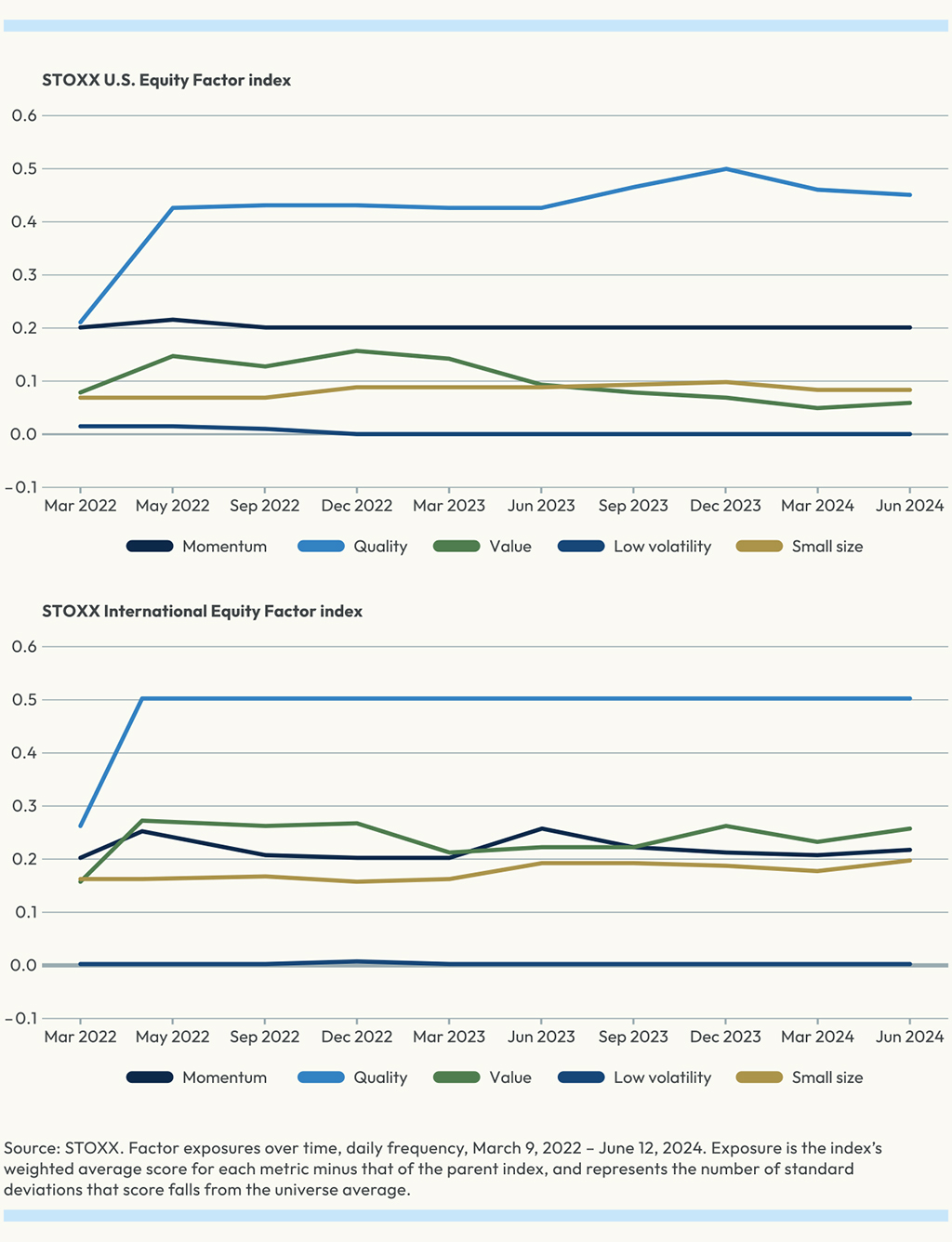In June 2022, BlackRock and STOXX teamed up as the asset manager enhanced its suite of multifactor ETFs with a balanced and modern style factor approach.
The collaboration resulted in six funds listed in the US, which aim to offer the lowest management fees in the industry for affordable access. The funds have amassed a combined USD 5.5 billion in assets in the past two years.[1] They are the following:
Figure 1: Equity Factor suite
| ETF | Index |
|---|---|
| iShares U.S. Equity Factor ETF (LRGF) | STOXX® U.S. Equity Factor Index |
| iShares International Equity Factor ETF (INTF) | STOXX® International Equity Factor Index[2] |
| iShares Global Equity Factor ETF (GLOF) | STOXX® Global Equity Factor[3] |
| iShares Emerging Markets Equity Factor ETF (EMGF) | STOXX® Emerging Markets Equity Factor |
| iShares U.S. Small-Cap Equity Factor ETF (SMLF) | STOXX® U.S. Small-Cap Equity Factor |
| iShares International Small-Cap Equity Factor ETF (ISCF) | STOXX® International Small-Cap Equity Factor[4] |
The 2022 collaboration included updating the iShares funds’ methodology with the most up-to-date factor research and systematic strategies conceived by BlackRock and STOXX.
Controlled factor exposure
Multifactor investing continues to attract strong interest as a way to distribute allocations across several sources of return premia, increasing opportunities for incremental returns and diversifying cyclical risks. The strategies have drawn sizeable inflows even amid a bull market as experienced in the last two years.
The STOXX Equity Factor indices were designed as core equity solutions that deliver above-average exposure to five factors: Quality, Value, Momentum, Low Size (small capitalization) and Low Volatility, while being mindful of diversification considerations, unintended systematic exposures and tracking error.
Figure 2: Target factors

Constructing multifactor indices with an optimized approach around exposures and risk targets helps avoid unintended and uncompensated bets such as a strong overload to one individual factor, large deviations from the benchmark or excessive transaction costs.
Performance
As we celebrate the first two years in this multifactor collaboration, we’ve analyzed the strategies’ performance. The focus of this analysis is on the first two offerings launched in June 2022 — the STOXX U.S. Equity Factor and the STOXX International Equity Factor. The suite was expanded in early 2023 to cover four more strategies/regions.
The multifactor indices have outperformed the market over the past one and three years, while showing similar risk characteristics and, as devised in the methodology, limited tracking error (Figure 3).
Figure 3: Performance comparison

“The last two years have shown that appetite for factor investing as an alpha-generation and risk-management exercise remains very strong,” said Robert Hum, BlackRock’s US Head of Factor ETFs. “Our multifactor ETF suite offers a balanced approach to five factors that have shown to be resilient across time, and we have made this strategy accessible to all investors in a low-cost, systematic and transparent manner.”
“An efficient factor strategy relies on key exposure design considerations, including an optimization strategy, robust risk models and key factor attributes,” said Arun Singhal, Global Head of Product Management at STOXX. “Our partnership with BlackRock allows us to combine our indexing and portfolio construction capabilities with industry-leading factor analytics and design, to accurately capture potential for long-term enhanced returns.”
Methodology
The indices are derived from STOXX’s broadest equity market universe, STOXX® World, a suite that allows investors to slice and dice global markets into flexible and modular investment blocks. From each parent index, constituents are selected and weighted through an optimization process that leverages the Axioma portfolio optimizer and seeks to maximize exposure to a multifactor alpha signal, derived from the combination of the five targeted factors.
Each factor follows fundamental metrics and quantifiable indicators that have proved to best capture the targeted style risk premium. These robust and contemporary factor definitions are key to driving returns and reducing risk.
During the optimization, the indices embed diversification considerations by applying caps across sectors, countries, individual companies and single-factor exposures. The methodology also controls for turnover and liquidity, and provides beta and tracking error ratios that don’t diverge significantly from the broad market.
Control of systematic exposures
The systematic limits on how much the index can be tilted toward any single factor create diversified factor profiles and prevent the indices from loading too much (or not enough) on one individual factor, which is a common issue faced by many existing multifactor strategies. As individual factors can be in or out of favor at different points of the market cycle, diversified factor exposures can play an important role in mitigating prolonged periods of underperformance.
Factor exposure
On backtested analysis, the STOXX Equity Factor indices have exhibited consistent target factor exposures over time. Figure 4 displays the historical active exposures to the targeted factors for the STOXX U.S. Equity Factor index and STOXX International Equity Factor indices.
Figure 4: Active factor exposure

Portfolio construction as value proposition
Because of its full-market-cycle performance potential, many investors tend to leverage a multifactor strategy in their core equity allocation. An efficient factor investing solution can be used in a strategic allocation or even in a dedicated factor investing sleeve.
The STOXX Equity Factor indices represent a well-researched, rules-based offering that can help investors avoid the inherent pitfalls of style-premia harvesting and cyclical headwinds. In their second year as underlying for iShares ETFs, they have proven to be a powerful factor-based value proposition.
[1] Data as of June 28, 2024.
[2] Index covers developed markets.
[3] Index covers developed and emerging markets.
[4] The STOXX International Small-Cap Equity Factor Index and the STOXX U.S. Small-Cap Equity Factor Index do not include low size as a target factor.
